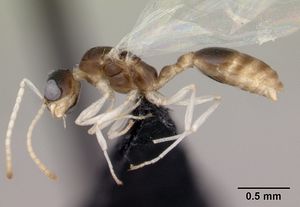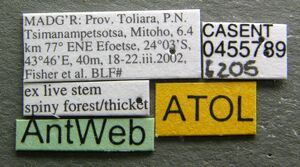Nesomyrmex cingulatus
| Nesomyrmex cingulatus | |
|---|---|

| |
| Scientific classification | |
| Kingdom: | Animalia |
| Phylum: | Arthropoda |
| Class: | Insecta |
| Order: | Hymenoptera |
| Family: | Formicidae |
| Subfamily: | Myrmicinae |
| Tribe: | Crematogastrini |
| Genus: | Nesomyrmex |
| Species group: | brevicornis |
| Species: | N. cingulatus |
| Binomial name | |
| Nesomyrmex cingulatus Csösz & Fisher, 2016 | |
This species is known to occur in the spiny forests of the southern part of Madagascar from 40–400 m. Specimens have been collected from live stems. (Csösz & Fisher 2016)
Identification
A member of the brevicornis species-group.
Keys including this Species
Distribution
Latitudinal Distribution Pattern
Latitudinal Range: -23.99222° to -25.58167°.
| North Temperate |
North Subtropical |
Tropical | South Subtropical |
South Temperate |
- Source: AntMaps
Distribution based on Regional Taxon Lists
Malagasy Region: Madagascar (type locality).
Distribution based on AntMaps
Distribution based on AntWeb specimens
Check data from AntWeb
Countries Occupied
| Number of countries occupied by this species based on AntWiki Regional Taxon Lists. In general, fewer countries occupied indicates a narrower range, while more countries indicates a more widespread species. |

|
Estimated Abundance
| Relative abundance based on number of AntMaps records per species (this species within the purple bar). Fewer records (to the left) indicates a less abundant/encountered species while more records (to the right) indicates more abundant/encountered species. |

|
Biology
Castes
Male
Images from AntWeb
    
| |
| Male (alate). Specimen code casent0455789. Photographer Erin Prado, uploaded by California Academy of Sciences. | Owned by CAS, San Francisco, CA, USA. |
Nomenclature
The following information is derived from Barry Bolton's Online Catalogue of the Ants of the World.
- cingulatus. Nesomyrmex cingulatus Csösz & Fisher, 2016: 140, figs 18-21 (w.) MADAGASCAR.
Unless otherwise noted the text for the remainder of this section is reported from the publication that includes the original description.
Description
Worker
Body color: yellow; brown. Body color pattern: concolorous, first gaster tergite darker. Absolute cephalic size: 459 [419, 515]. Cephalic length vs. maximum width of head capsule (CL/CWb): 1.37 [1.30, 1.45]. Postocular distance vs. cephalic length (PoOc/CL): 0.51 [0.49, 0.52]. Postocular sides of cranium contour frontal view orientation: converging posteriorly. Postocular sides of cranium contour frontal view shape: broadly convex. Vertex contour line in frontal view shape: straight. Vertex sculpture: main sculpture absent, ground sculpture areolate. Setal pits on head dorsum: surrounded by conspicuous foveae with well-demarcated margins. Diameter of foveae on head dorsum: 15-20 μm. Gena contour line in frontal view shape: straight. Genae contour from anterior view orientation: converging. Gena sculpture: rugoso-reticulate with areolate ground sculpture; ground sculpture areolate, main sculpture absent. Concentric carinae laterally surrounding antennal foramen: present. Eye length vs. absolute cephalic size (EL/CS): 0.24 [0.22, 0.26]. Frontal carina distance vs. absolute cephalic size (FRS/CS): 0.31 [0.30, 0.33]. Longitudinal carinae on median region of frons: absent. Smooth median region on frons: absent. Antennomere count: 12. Scape length vs. absolute cephalic size (SL/ CS): 0.63 [0.60, 0.65]. Median clypeal notch: present. Ground sculpture of submedian area of clypeus: present. Median carina of clypeus: absent. Metanotal depression: present. Dorsal region of mesosoma sculpture: ground sculpture areolate, main sculpture absent. Lateral region of pronotum sculpture: ground sculpture areolate, main sculpture absent. Mesopleuron sculpture: ground sculpture areolate, main sculpture absent. Metapleuron sculpture: ground sculpture areolate, main sculpture absent. Petiole width vs. absolute cephalic size (PEW/CS): 0.22 [0.21, 0.24]. Dorsal region of petiole sculpture: ground sculpture areolate, main sculpture absent. Postpetiole width vs. absolute cephalic size (PPW/CS): 0.32 [0.28, 0.35]. Dorsal region of postpetiole sculpture: ground sculpture areolate, main sculpture absent. Surface of first gastral tergite: continuously imbricate.
Type Material
Holotype: CASENT0919845, collection code: BLF06205, Parc National de Tsimanampetsotsa, Mitoho Cave, 6.4 km 77° ENE Efoetse, 17.4 km 170° S Beheloka, -24.04722°, 43.75317°, alt 40 m, Fisher-Griswold Arthropod Team, 03.18.2002, (1w, California Academy of Sciences, CASENT0919845); Paratypes: 22 workers and a gyne from the same locality under CASENT codes: CASENT0455751, collection code: BLF06204, (2w, CASC); CASENT0455757, collection code: BLF06205, (2w, CASC); CASENT0455756, collection code: BLF06205, (3w, CASC); CASENT0455755, collection code: BLF06205, (3w, CASC); CASENT0455759, collection code: BLF06205, (1Q, CASC); CASENT0455750, collection code: BLF06204, (3w, CASC); CASENT0455752, collection code: BLF06204, (3w, CASC); CASENT0455753, collection code: BLF06204, (3w, CASC); CASENT0455754, collection code: BLF06204, (3w, CASC).
Etymology
The name (cingulatus) refers to the conspicuous dark brown transversal patch on the first gastral tergite of workers of this species.

